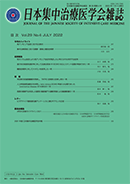Volume 29, Issue 4
Displaying 1-11 of 11 articles from this issue
- |<
- <
- 1
- >
- >|
-
2022Volume 29Issue 4 Pages 265
Published: July 01, 2022
Released on J-STAGE: July 22, 2022
Download PDF (112K)
HIGHLIGHTS IN THIS ISSUE
-
2022Volume 29Issue 4 Pages 267-268
Published: July 01, 2022
Released on J-STAGE: July 01, 2022
Download PDF (576K) -
2022Volume 29Issue 4 Pages 269-270
Published: July 01, 2022
Released on J-STAGE: July 01, 2022
Download PDF (578K)
CASE REPORTS
-
Article type: case-report
2022Volume 29Issue 4 Pages 271-274
Published: July 01, 2022
Released on J-STAGE: July 01, 2022
Download PDF (717K) -
Article type: case-report
2022Volume 29Issue 4 Pages 275-279
Published: July 01, 2022
Released on J-STAGE: July 01, 2022
Download PDF (7400K) -
Article type: case-report
2022Volume 29Issue 4 Pages 280-283
Published: July 01, 2022
Released on J-STAGE: July 01, 2022
Download PDF (639K)
BRIEF REPORTS
-
Article type: brief-report
2022Volume 29Issue 4 Pages 285-286
Published: July 01, 2022
Released on J-STAGE: July 01, 2022
Download PDF (635K) -
Article type: brief-report
2022Volume 29Issue 4 Pages 287-289
Published: July 01, 2022
Released on J-STAGE: July 01, 2022
Download PDF (659K) -
Article type: brief-report
2022Volume 29Issue 4 Pages 290-291
Published: July 01, 2022
Released on J-STAGE: July 01, 2022
Download PDF (1203K)
LETTER
-
Article type: letter
2022Volume 29Issue 4 Pages 293
Published: July 01, 2022
Released on J-STAGE: July 01, 2022
Download PDF (534K)
COMMITTEE REPORT
-
Article type: meeting-report
2022Volume 29Issue 4 Pages 295-332
Published: July 01, 2022
Released on J-STAGE: July 22, 2022
Download PDF (1250K)
- |<
- <
- 1
- >
- >|
